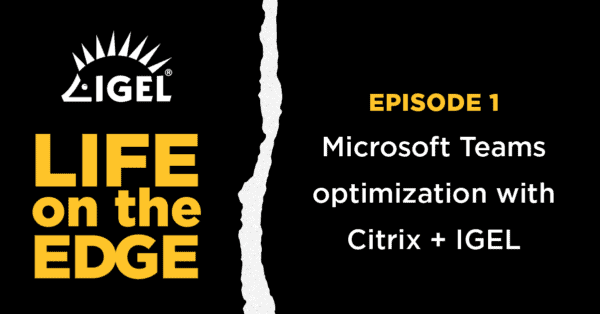IGEL Blog

Recycling Innovation: If Adidas Can Do It, So Can the IT Industry…..
David Beckman wears them. So, does Lionel Messi and Taylor Swift. But it has to be New York hip hop pioneers, Run DMC, who take the celebrity prize for loving their (unlaced) Adidas trainers the most. Why? They sang about them in their 1986 hit “My Adidas” which reached no.5 in the Hot Black charts.
Celebrities wearing cool trainers might not come as much of a surprise. What’s more interesting is Adidas’ public position on sustainability and how its products are now made. Through a partnership with environmental organisation, Parley for the Oceans – which dates back to 2015 – the business uses plastic collected from the sea to make some footwear, clothing and accessories. In 2022, close to 27 million shoes were made from the stuff, with Adidas also announcing it will only use recycled polyester across the board from 2024.
This idea of being creative, recycling and reusing – rather than making brand new – should set an example and be copied by the IT industry.
Take end user computing (EUC). It has become a major contributor to environmental pollution and climate change, directly and indirectly causing around 2% of global greenhouse gas emissions. 1% of this is due to the yearly manufacture of 460 million devices and the associated energy consumption by 4.2 billion users. This emits a whopping 556 million tons of CO2 and would require a forest the size of Argentina to remove from Earth’s atmosphere annually. A further 1% is attributed to the pollution associated with people commuting to access IT in the workplace.[1]
Other stats support this bleak picture. According to the Chartered Institution of Wastes Management, the UK produced the second largest amount of e-waste as a country in 2022 at 23.9 kg per capita. The study also showed that IT and telecoms e-waste almost doubled between 2008 (19,053 tonnes) to 2022 (37,631 tonnes estimated).
Displacement saves resources, money and the environment
We’re drowning in a tsunami of e-waste. One of the reasons for this is the technology refresh hamster wheel of upgrades which has become commonplace in the public and private sector. Most PCs or laptops are updated every 3 to 4 years as they break or OS vendors introduce major new releases requiring updated hardware to run.
Repurposing device hardware – a so-called displacement strategy – is a tried and tested way of avoiding this and has been at the heart of IGEL’s EUC strategy since 2011.
This approach extends the existing device’s useful lifespan and consequently causes the emissions of replacement devices – both from a manufacturing and shipping perspective – not to be required. This is key given 83% of a device’s carbon footprint is created during manufacture.
This gains added impetus given the UK’s Climate Change Act 2008 includes an amendment to the Companies Act 2006 requiring all London Stock Exchange listed companies, large unquoted firms and limited liability partnerships to report their greenhouse gas emissions. Public sector organisations are also required to adopt sustainable IT practices in relation to Scope 2 and Scope 3 emissions.
Sadly, inertia exists. Many IT departments simply do not know enough about sustainable ICT purchasing or think that it requires more money to achieve, such research reveals that over a third simply take no action[2]. This is not only a dreadful for the environment but presents a significant missed opportunity for organisations to play a more effective role to address the climate emergency.
Mini case study: greenhouse gas abatement at a major UK financial institution
Some firms, however, have grappled with the whole issue of how to consume IT in an environmentally optimum way. IT carbon footprint consultancy, PX3, has independently analyzed in detail an IGEL project at a well-known UK financial institution, the details and benefits of which are summarized below.
To enable work from home during the Covid crisis in 2020, the company faced the problem of how to provide secure remote working for 3,150 staff or 86% of employees. It had the choice of whether to buy new HP T640 thin client hardware and recycle old Dell OptiPlex 7010 desktops or repurpose the PCs replacing Windows 7 Pro with IGEL OS, thereby turning them into thin client devices.
The customer chose to repurpose each PC, and combined with an existing 24” monitor, mouse and keyboard, created an ‘office in a box’ which was delivered to staff at home. They then connected to a Citrix VDI environment to access their applications.
The costs and impact of buying new
If HP T640 thin clients had been used, the PX3 analysis shows that new hardware over a 5-year period would have generated 425,983 kg of CO2e. This comprises Scope 2 emissions for the duration, Scope 3 emissions for year 1 – the delivery of new devices – and then the recycling of these units at the end. In more simple terms, the emissions are equivalent to 1,543,640 car miles and would have required 511 of mature forest to sequester the pollution.
From a cost perspective, given each HP device is circa £300, the cost to replace the estate of 3,150, would have totalled £945,000. Electricity charges over the period for all devices – based on an average price of £0.172 per kWh – are £47,462. In summary, a total cost of ownership (TCO) of £992,462.
Repurposing the old – a better way
As the Dell OptiPlex 7010 PCs already existed, the reported Scope 3 emissions of 218 kgCO2e per device were already accounted for, such that retaining them added zero emissions.
Running the existing PCs with new IGEL OS installed and measuring energy consumption showed a 22% decrease in power compared to Windows 7 Pro. Therefore, over the 5-year lifecycle extension period, the total carbon consumed by the Dell PCs totalled 169,945 kg of CO2e (Scope 2) and 0 kg of CO2e related to Scope 3. Again, in more simple terms, the emissions equate to 615,832 car miles or 204 of mature forest to sequester the pollution.
Turning to money, no purchase value is applied to existing Dell OptiPlex 7010 computers as they were accounted for in year one of purchase. However, buying 3,150 IGEL OS perpetual licenses cost £315,000.
Additionally, the utility charges for the same period were £137,644 for the Dell PCs based upon the same per kWh pricing of £0.172. This means a TCO attributed to the displacement strategy of £452,644.
The financial and environmental payoff
There’s a lot of data in this blog post. But to boil it down, a displacement strategy is clearly better, delivering:
60% reduction in carbon footprint across a 5-year period by repurposing devices;
- Potential combined Scope 2 and 3 emissions dropping from 425,983 kgCO2e to 169,945 kgCO2e – equivalent to avoiding 927,808 car miles or the sequestering capacity of 307 forest acres.
- 55% drop in project costs from £992,462 to £452,644 over the 5-year period meaning the company saved an impressive £539,818.
 Even with IGEL OS demanding less power than Windows, the analysis shows that energy consumption of the existing old Dell devices was 65% higher than the replacement HP thin clients.
Even with IGEL OS demanding less power than Windows, the analysis shows that energy consumption of the existing old Dell devices was 65% higher than the replacement HP thin clients.
However, the impact of the manufacturing emissions far outweighs the energy emissions gain from buying new; it would take an additional 17 years for this cross over to happen, by which time the Dell PCs would be practically prehistoric and definitely need recycling.
The knee jerk position in many IT departments is to throw away and buy new – just like a pair of trainers. It’s not necessary. We can reuse, reimagine and recycle hardware – easily doubling lifespan – by running applications, storage and compute in the cloud and not on the endpoint. That means the requirement to have the latest and greatest desktop is removed with only a lightweight OS which we provide needed to connect to modern VDI or DaaS workspaces from the likes of Microsoft, Amazon, Citrix and VMware.
And on top of this, the IGEL UMS management platform means one person can simply manage circa 20,000 devices from a single location resulting in fewer support engineers driving to site to do break/fix and therefore polluting less. Which leads me back to the beginning theme of this blog and Run DMC loving Adidas. IT staff should Run UMS. They’ll love IGEL, too.
To read the full report PX3 click here.
[1]Source: Dr. Justin Sutton-Parker, CEO of PX3 and a Research Fellow at the University of Warwick
[2]Source: Sutton-Parker


